- Author: Lynn M. Sosnoskie
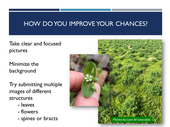
The importance of proper weed identification
Weeds are a problem in a variety of systems, from agronomic and horticultural crops, to orchards and vineyards, to turf and ornamentals, to rangelands, and to natural areas. The first step in developing a successful weed management program is to ensure that the unwanted vegetation has been identified correctly. Not all weeds respond equally well to all treatment measures. For example, broadleaf weeds will be managed by the auxinic herbicides (WSSA Group 4) whereas grasses will not. Mowing may be more effective at suppressing upright growing species as opposed to those that are more prostrate. Shallow cultivation may control annual weed species while missing...
- Author: Lynn M. Sosnoskie
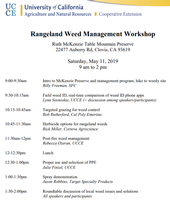
When: Saturday, May 11
Time: 9:00am to 2:00pm
Where: Ruth McKenzie Table Mountain Preserve (22477 Auberry Rd, Clovis, CA 93619, Fresno County)
There will be a hands-on, field-based extension day exploring weed identification, management options, and local best practices for the control of problem vegetation inrangelend systems on May 11 at RuthMacKenzie Table Mountain Preserve (22477 Auberry...
- Author: Lynn M. Sosnoskie
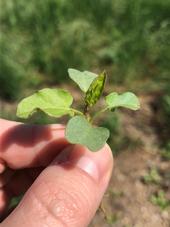
Field bindweed (Convolvulus arvensis) is a perennial vine native to the Mediterranean region of Europe and Northern Africa that has become naturalized throughout much of the world. The species can reproduce vegetatively (through the spread of rhizomes) and via seed production. Field bindweed seedlings can be distinguished from emerging perennial vines by the presence of two square- to kidney-shaped cotyledons. Leaves are arrow-shaped and alternate along the developing stem. The true leaves of seedlings resemble those on mature vines (just being smaller in size to start). Within six weeks of emergence, the seedlings have developed a taproot and a significant number of lateral roots. For more information about field bindweed,...
- Author: Lynn M. Sosnoskie
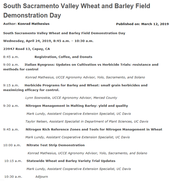
The South Sacramento Valley Wheat and Barley Field Demonstration Day will be held from 8:45 - 10:30AM on April 24th, 2019 in the Dunnigan Hills area. The program will feature UC small grain research on weed management, nitrogen management and variety testing. CUEs for Nutrient Management (0.5) and Integrated Pest Management (0.5) will be offered. Please see the following link for more information: https://ucanr.edu/blogs/blogcore/postdetail.cfm?postnum=29668
- Author: Lynn M. Sosnoskie
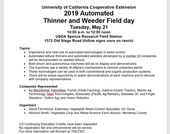
2019 Automated Weeder and Thinner Demonstration and Field Day
The 2019 Automated Weeder and Thinner Demonstration and Field day will take place on Tuesday, May 21, from 10:00 a.m. to 12:00 noon at the USDA Spence Research Field Station, 1572 Old Stage Road in Salinas. Automated technologies are helping to fill the gap in the supply of labor that is occurring in the farming community. At this field day weeders and automated lettuce thinners developed by a number of companies will be demonstrated on lettuce plantings. Both driven and autonomous machines that use a variety of different mechanisms to remove unwanted plants will be available for viewing. These technologies are useful to both conventional and organic...



